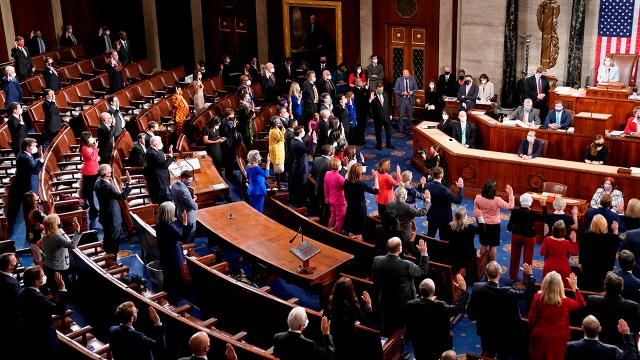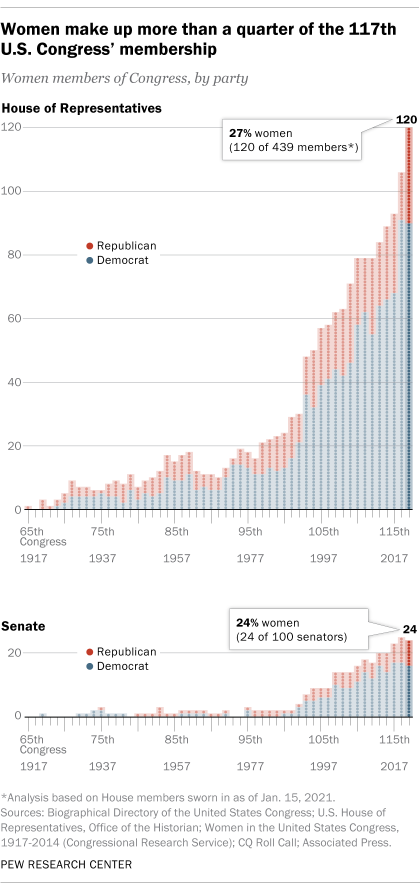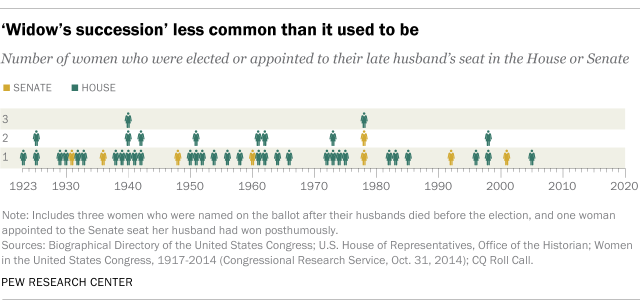How Many Males Are in the House of Representatives

Women brand up only over a quarter of all members of the 117th Congress – the highest per centum in U.S. history and a considerable increase from where things stood even a decade ago.

Counting both the House of Representatives and the Senate, 144 of 539 seats – or 27% – are held by women. That represents a fifty% increment from the 96 women who were serving in the 112th Congress a decade ago, though it remains far below the female person share of the overall U.S. population. A record 120 women are serving in the newly elected House, accounting for 27% of the total. In the Senate, women hold 24 of 100 seats, one fewer than the tape number of seats they held in the last Congress.
This analysis counts voting as well as nonvoting members of Congress. Figures for the 117th Congress exclude two Firm seats that were vacant as of early on January. Information technology besides excludes Sens. Kamala Harris, who is expected to resign her seat alee of her inauguration as vice president on Jan. xx, and Kelly Loeffler, who lost a runoff election in Georgia before this month. Both are gear up to be replaced by men.
This analysis builds on earlier Pew Inquiry Center work to analyze the gender makeup of Congress.
In the Firm, ane New York race has not been called all the same, and one Louisiana seat is empty considering the congressman-elect died before he could exist sworn in. Both seats were vacant when Congress was sworn in on Jan. 3, 2021, then the current number of representatives is 439. This analysis includes nonvoting members.
Independent members of Congress are counted with the party they conclave with.
Considering Sen. Kamala Harris will ascend to the vice presidency this month, we are not including her in the count of female person senators. We are, however, counting her seat as Democrat-held because a Democrat has been named to take her place.
For historical data on Congress, we used data from the Biographical Directory of the The states Congress, the U.S. House of Representatives Office of the Historian, the Congressional Enquiry Service's "Women in the Usa Congress, 1917-2014" and CQ Ringlet Telephone call. For 2020-21 election results, we used information from Ballotpedia and the Associated Press, as well as news reports.
Women brand upwardly a much bigger share of congressional Democrats (38%) than Republicans (14%). Across both chambers, there are 106 Democratic women and 38 Republican women in the new Congress. Women account for 40% of House Democrats and 32% of Senate Democrats, compared with 14% of House Republicans and sixteen% of Senate Republicans.
The 2022 general ballot sent but 1 new congresswoman to the Senate, Republican Cynthia Lummis of Wyoming, making her the first female person senator to correspond that state.
Republican women made significant gains in the Firm in the most contempo election cycle. Of the 27 newly elected representatives who are women, two-thirds (eighteen) are Republicans. Between the 115th and 116th Congresses, the number of GOP women in the House fell from 25 to 15. That number doubled this yr to 30, the highest total always.
California Rep. Nancy Pelosi, a Democrat and the first female speaker of the House, is serving her fourth term as speaker later on being reelected earlier this month.
The partisan gender division hasn't always looked this way. Until the 1929 stock market crash, most of the dozen women elected to the House were Republicans, and for several decades afterwards the 2 parties were generally close in numbers in that chamber. Merely the gap widened in the 1970s and has persisted, despite a temporary narrowing during the Reagan-Bush 1980s. Of the 232 women elected to the House in 1992 or later, 157 (68%) take been Democrats, as accept 27 of the 42 women (64%) who accept served in the Senate since 1992.
The history of women in Congress

Women take been in Congress for more than a century. The starting time, Republican Jeannette Rankin of Montana, was elected to the Business firm in 1916, two years subsequently her land gave women the vote. But it'due south merely been in the past few decades that women take served in more than substantial numbers. Near 2-thirds of the women ever elected to the Firm (232 of 352, including the newest members of the 117th Congress) have been elected in 1992 or afterward.
The blueprint is like in the Senate: 42 of the 58 women who take e'er served in the Senate – including Lummis, the newest female senator – took office in 1992 or later.
The 19th Subpoena, which extended the franchise to women across the nation, was ratified in 1920. That November, Alice Mary Robertson of Oklahoma became the beginning woman to defeat an incumbent congressman. (She lost the seat dorsum to him two years later.) In 1922, veteran suffragist Rebecca Latimer Felton of Georgia was appointed to fill a vacant Senate seat; when Congress was unexpectedly called back into session, Felton was sworn in every bit the commencement-ever female person senator, though she only served for a 24-hour interval.
While women remained scarce in the Senate well into the 1980s, their numbers gradually, though not consistently, increased in the Firm – generally paralleling the expansion of women's roles in society more than broadly. In 1928, vii women were elected to the 71st Congress, a record at the fourth dimension, and 2 more joined them afterwards via special election. But that tendency plateaued during the Keen Depression and World War II. It wasn't until after the war that the upward trajectory of women in Congress resumed, with 18 women serving in the Firm in 1961-62.
Although the 1970s saw prominent figures such as Barbara Jordan, Elizabeth Holtzman and Bella Abzug enter Congress, women'south overall numbers didn't change much until 1981, when their House caucus exceeded 20 members for the kickoff fourth dimension. The big bound, however, came in 1992 – later dubbed "The Year of the Woman" – when four new female senators and 24 new congresswomen were elected. Academics have offered diverse explanations for why 1992 was such a breakthrough yr for women in Congress, including an unusually large number of open seats due to redistricting and backfire from the Clarence Thomas-Anita Hill hearings.
'Widow's succession' in Congress
Well into the 1970s, i of the about mutual ways for a woman to enter Congress was by succeeding her deceased married man or father, either by election or date. Of the ninety women who served in the Business firm between 1916 and 1980, 31 were initially elected to their husband's seat later on he died; three were chosen to replace their husbands on the ballot when the men died earlier Election 24-hour interval; and ane, Winnifred Stonemason Huck of Illinois, was elected in 1922 to fill the concluding iv months of her late father's term. (Some other early congresswoman, Katherine Gudger Langley of Kentucky, won her husband'due south seat in 1926 after he resigned following his confidence for violating Prohibition laws.)

Like Langley, most of the holders of these and then-called "widow's succession" seats stayed in Congress for only a term or 2. But some went on to distinguished careers on Capitol Hill. Margaret Chase Smith of Maine, for case, won a special ballot in 1940 to fill the last vii months of her hubby'south term. Smith went on to win four full House terms on her own, so was elected to four terms in the Senate, thereby becoming the first adult female to serve in both chambers. Lindy Boggs, who was elected to her husband's seat in 1973 afterward he was presumed killed in a aeroplane crash, served nearly 18 years. She after was named U.S. administrator to the Holy See.
Six of the 14 women who served in the Senate before 1980 were either elected or appointed to fill up their belatedly husbands' seats. Of those, just two (Hattie Caraway of Arkansas and Maurine Brownish Neuberger of Oregon) subsequently won full terms in their ain correct.
Note: This is an update of a post originally published December. 18, 2018.
simmonsharanded99.blogspot.com
Source: https://www.pewresearch.org/fact-tank/2021/01/15/a-record-number-of-women-are-serving-in-the-117th-congress/
0 Response to "How Many Males Are in the House of Representatives"
Enviar um comentário